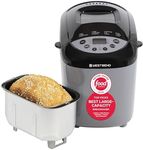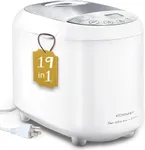Buying Guide for the Best Bread Makers
Choosing a bread maker can be a rewarding experience, especially if you love the idea of fresh, homemade bread with minimal effort. The right bread maker will fit your kitchen space, match your baking habits, and offer the features you’ll actually use. Before you buy, think about how often you plan to bake, what types of bread you enjoy, and how much bread you typically eat. Understanding the key features will help you find a model that makes baking easy and enjoyable.Loaf Size CapacityLoaf size capacity refers to the maximum size of bread the machine can bake, usually measured in pounds or grams. This is important because it determines how much bread you can make in one go. Bread makers typically offer options like 1 lb, 1.5 lb, or 2 lb loaves. Smaller capacities are great for singles or couples, while larger ones suit families or those who like to bake in bulk. Consider your household size and how quickly you go through bread to pick the right capacity for you.
Number and Type of ProgramsBread makers come with preset programs for different types of bread, such as white, whole wheat, gluten-free, or even dough for pizza and pasta. The number and variety of these programs affect how versatile your machine is. Some models offer just a few basic settings, while others have a wide range, including options for cakes or jams. If you like experimenting with different recipes, look for a machine with more programs. If you mostly want to make standard bread, a simpler model will do.
Crust Color SettingsCrust color settings let you choose how light or dark you want your bread’s crust to be. This feature is important if you have a strong preference for a soft or crispy crust. Most bread makers offer at least three settings: light, medium, and dark. If you’re particular about crust texture, make sure your chosen model has adjustable settings. If you’re not fussy, this may not be a deciding factor.
Delay TimerA delay timer allows you to set the bread maker to start baking at a later time, so you can wake up or come home to fresh bread. This is especially useful for busy schedules or for having bread ready for breakfast. Delay timers usually range from a few hours up to 13 or 15 hours. If you want the convenience of fresh bread at specific times, look for a model with a flexible delay timer.
Kneading PaddlesKneading paddles are the parts that mix and knead the dough. Some bread makers come with one paddle, while others have two for more thorough mixing. Removable or collapsible paddles make cleaning easier and can help reduce the hole left in the bottom of the loaf. If you plan to bake a variety of breads or want easy cleanup, consider the paddle design and whether extra paddles are included.
Viewing WindowA viewing window lets you watch the bread as it bakes without opening the lid. This is helpful for checking progress and ensuring everything is going smoothly. While not essential, it can be a fun and reassuring feature, especially for beginners. If you like to monitor your baking, look for a model with a clear, well-placed window.
Keep Warm FunctionThe keep warm function keeps your bread warm after baking, usually for up to an hour. This is useful if you can’t remove the bread right away and want to enjoy it fresh. If your schedule is unpredictable or you like to bake overnight, this feature can be very handy. If you always plan to be present when the bread finishes, it may not be as important.
Ease of CleaningEase of cleaning refers to how simple it is to clean the bread pan, paddles, and other parts. Nonstick pans and removable components make cleaning much easier. If you want to avoid hassle after baking, look for a bread maker with dishwasher-safe or easy-to-wipe parts. If you don’t mind a bit of scrubbing, this may be less of a concern.


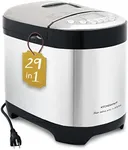
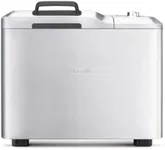
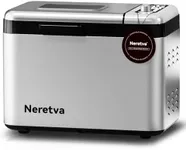


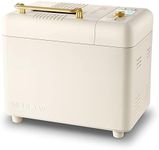



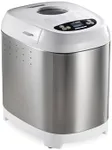
![Panasonic SD-MDX4-K [Home Bakery Bistro 1 loaf type black] AC100V Japanese Language ONLY Shipped from Japan 2021 Released](https://images-proxy.bestreviews.guide/Ymzuhpz39I3-hhan1kIFknrImQM=/0x150/https://m.media-amazon.com/images/I/31iViP9qu8S._AC_CX679_.jpg)
